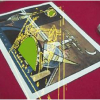Free Online Productivity Tools
i2Speak
i2Symbol
i2OCR
iTex2Img
iWeb2Print
iWeb2Shot
i2Type
iPdf2Split
iPdf2Merge
i2Bopomofo
i2Arabic
i2Style
i2Image
i2PDF
iLatex2Rtf
Sci2ools
ICCV
1999
IEEE
1999
IEEE
Projective Alignment with Regions
?We have recently proposed an approach to recognition that uses regions to determine the pose of objects while allowing for partial occlusion of the regions. Regions introduce an attractive alternative to existing global and local approaches, since, unlike global features, they can handle occlusion and segmentation errors, and unlike local features they are not as sensitive to sensor errors, and they are easier to match. The region-based approach also uses image information directly, without the construction of intermediate representations, such as algebraic descriptions, which may be difficult to reliably compute. In this paper, we further analyze properties of the method for planar objects undergoing projective transformations. In particular, we prove that three visible regions are sufficient to determine the transformation uniquely and that for a large class of objects, two regions are insufficient for this purpose. However, we show that when several regions are available, the pose ...
Computer Vision | ICCV 1999 | Partial Occlusion | Planar Objects | Projective Transformations | Segmentation Errors | Visible Regions |
Related Content
| Added | 15 Oct 2009 |
| Updated | 31 Oct 2009 |
| Type | Conference |
| Year | 1999 |
| Where | ICCV |
| Authors | Ronen Basri, David W. Jacobs |
Comments (0)

